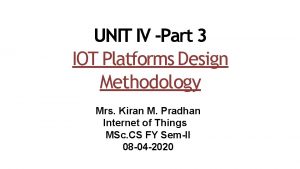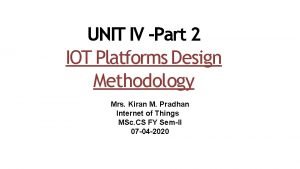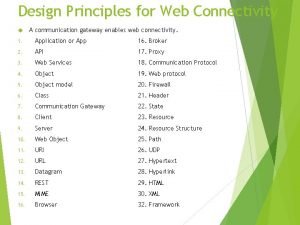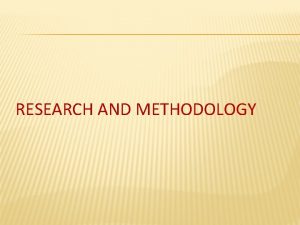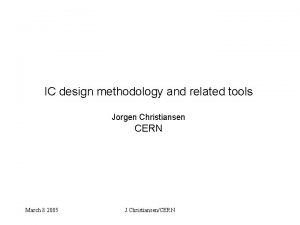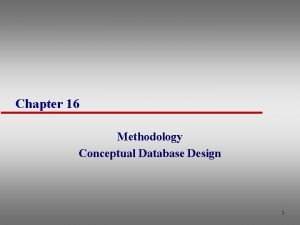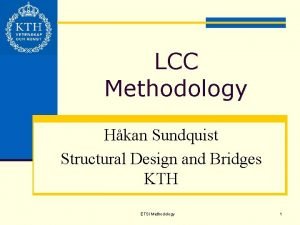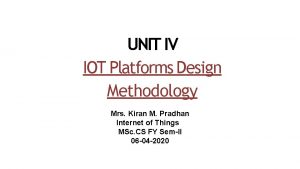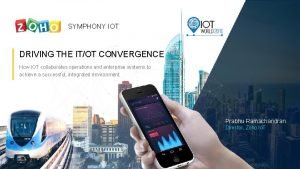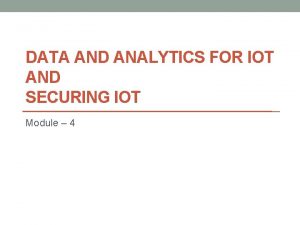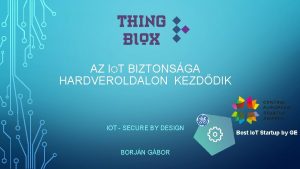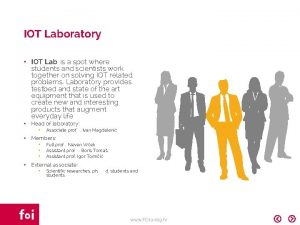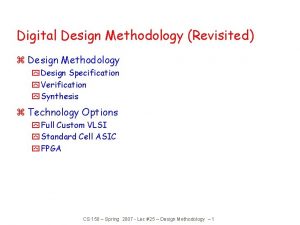UNIT IV Part 5 IOT Platforms Design Methodology
















- Slides: 16

UNIT IV -Part 5 IOT Platforms Design Methodology Mrs. Kiran M. Pradhan Internet of Things MSc. CS FY Sem-II 10 -04 -2020

IOT Platforms Design Methodology It includes: Purpose & Requirements Specification Process Specification Domain Model Specification Information Model Specification Service Specification

IOT Platforms Design Methodology Io. T Level Specifications Functional view Specification Operational View Specification Device & component Integration Application Development

Device & component Integration The devices and components used in this example are Raspberry Pi mini computer, LDR sensor and relay switch actuator.

Application Development The application has controls for the mode (auto on or auto off) and the light (on or off). In the auto mode, the Io. T system controls the light appliance automatically based on the lighting conditions in the room. When auto mode is enabled the light control in the application is disabled and it reflects the current state of the light. When the auto mode is disabled, the light control is enabled and it is used for manually controlling the light.

Application Development

Case Study Weather Monitoring System The purpose of the weather monitoring system is to collect data on environmental conditions such as temperature, pressure, humidity and light in an area using multiple end nodes. The end nodes send the data to the cloud where the data is aggregated analyzed.

Case Study Weather Monitoring System Figure shows the process specification for the weather monitoring system. The process specification shows that the sensors are read after fixed intervals and the sensor measurements are stored.

Case Study Weather Monitoring System In this domain model the physical entity is the environment which is being monitored. There is a virtual entity for the environment. Devices include temperature sensor, pressure sensor, humidity sensor, light sensor and single-board mini computer. Resources are software components which can be either on-device or network-resources. Services include the controller service that monitors the temperature , pressure deriving the services from the process specification and information model for the weather monitoring system, humidity and light and sends the readings to the deriving the services from the process specification and information model for the weather monitoring system.

Case Study Weather Monitoring System(domain model )

Case Study Weather Monitoring System(controller service ) • The controller service runs as a native service on the device and monitors temperature, pressure, humidity and light once every 15 seconds. • The controller service calls the REST service to store these measurements in the cloud.

Case Study Weather Monitoring System (deployment design for the system ) • The system consists of multiple nodes placed in different locations for monitoring temperature, humidity and pressure in an area. • The end nodes are equipped with various sensors. • The end nodes send the data to the cloud and the data is stored in a cloud database. • The analysis of data is done in the cloud to aggregate the data and make predictions

Case Study Weather Monitoring System Mapping deployment level to functional groups for the weather monitoring system.

Case Study Weather Monitoring System Mapping functional Groups to operational view specifications for the weather monitoring system.

Case Study Weather Monitoring System(controller service ) The schematic diagram of the weather monitoring system. The devices and components used in this example are Raspberry Pi mini computer, temperature sensor, humidity sensor, pressure sensor and LDR sensor.

Thank you Ref: IOT by Ashdeep Bahga &Vijay Madisetti 51
 The fourth step in the iot design methodology is
The fourth step in the iot design methodology is What is iot design methodology
What is iot design methodology Services in operational view specifications are
Services in operational view specifications are Design principles for web connectivity
Design principles for web connectivity Unit 10, unit 10 review tests, unit 10 general test
Unit 10, unit 10 review tests, unit 10 general test Method procedure example
Method procedure example Program design methodology
Program design methodology Design research methodology
Design research methodology Variables in research methodology
Variables in research methodology Database design methodology
Database design methodology Ic design methodology
Ic design methodology Digital design methodology
Digital design methodology Database design methodology
Database design methodology Structured design methodology
Structured design methodology Structured system analysis and design methodology
Structured system analysis and design methodology Goal directed design
Goal directed design Structural design methodology
Structural design methodology
